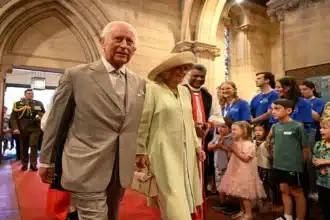Inflation Takes a Leap: As consumer prices unexpectedly climbed last month, defying projections of remaining steady, the Federal Reserve faces a complex task in balancing inflation control and economic growth support. The 0.1 percent uptick in the consumer price index to 3.2 percent annual growth, driven mainly by heightened services costs like insurance and healthcare, signals inflation persisting above the two percent target and warrants caution in adjusting borrowing rates from their current peak.
Inflation Takes a Leap: US Rate Hits 3.2%
At the critical March meeting, the Fed must not only maintain or modify interest rates from their highest level in over two decades but also communicate its intentions for potential cuts over the coming year, currently foreseeing as many as three reductions. Apollo Global Management’s lead economist Torstein Sløk highlighted how the sideways inflation trend complicates efforts to engineer a soft landing, requiring a measured revision to the policy outlook.
News of the inflation data immediately influenced financial markets, with two-year Treasury yields incrementally climbing in response to an adjusted outlook for easing. Similarly, ten-year yields edged higher on amplified expectations surrounding the timing of upcoming moves on rates. The implications stretch through government bonds to shifting investor perspectives on the monetary policy path.
The currency and share markets significantly responded to the inflation data with notable shifts. The value of the US dollar strengthened against a basket containing six other major currencies while stock trading on Wall Street experienced high volatility, ultimately registering mid-morning gains in New York. These marketplace dynamics underscore the broader economic uncertainties and delicate balance the Federal Reserve must maintain in its policy decisions.
Economists and financial experts are now closely monitoring the response from the Federal Reserve to these developments. The persistence of inflation, particularly in core categories excluding unpredictable food and energy costs, presents a formidable challenge. The core inflation rate marginally decreased from 3.9% in January to 3.8%, contrary to expectations of a drop to 3.7%, highlighting the stubborn nature of underlying price pressures.
Also Read: AI’s Energy Demand Sparks a New Era for Nuclear Power
As the Federal Reserve prepares for its upcoming meeting, the recent consumer price index information will undoubtedly play a critical role in shaping its interest rate policies. With the February personal consumption expenditures figure—another key inflation measure watched by the Fed—not due to be reported until after the March 20 decision, the CPI data becomes even more pivotal in the central bank’s deliberations.
Also Read: Applebee’s and IHOP Unite: Introducing Dual-Branded Diners Serving Favorites Under One Roof
Economists and market members alike are bracing for a potentially prolonged period of inflation management, with the journey from a 3% to a 2% inflation rate anticipated to be significantly more difficult than the initial reduction from higher levels. This evolving economic landscape presents a complex backdrop for the Federal Reserve’s policy maneuvers, as it seeks to balance inflation control with the imperative to support a still-resilient US economy.




